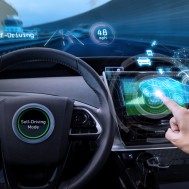The recent legal battle between tech giants Uber and Waymo has thrust self-driving car technology back into the spotlight, but it wouldn’t be accurate to say it was exactly standing in the shadows before. In fact, one could argue that the crux of this matter is the indisputable fact that self-driving cars are the future of the auto industry.
Any automobile manufacturers failing to plan for this turn of events will soon find themselves falling behind, as it has been forecasted that by 2020, 10 million self-driving cars will be on the road.
However, it’s not the certainty of this technology that holds the allure, it’s simply having the option. Keep reading for more reasons on why self- driving cars are the future of the auto industry.
1. The choice to drive or not to drive is appealing to customers.
For some, the instinctive reaction to hearing about self-driving technology is to reminisce on all the driving they’ll be missing out on. To many, there’s something intrinsically American about going for a Sunday afternoon drive or taking the long way home.
Not so fast, say executives at McKinsey offices in Detroit, who are leading the company’s automotive efforts. We’re going to have a situation where some people enjoy driving and continue, or those that don’t trust computers. And you’ll have some people who quite happily hand over control over their car.
A traffic jam setting offers a scenario where more drivers would perhaps want to take advantage of this technology. Here, they would have the peace of mind that they could relax behind the wheel and not have to worry themselves with the situation at hand.
2. Self-driving cars are laying the groundwork for full autonomy.
It’s important to understand that real tech insiders don’t use the terms “self- driving” and “driverless” as synonyms. Rather, self-driving is the now, and actual “driverless” cars will happen next.
Self-driving cars, as we understand them now, are described to be like having cruise control, but for the whole car. The difference is that fully autonomous cars are capable of operating without direct driver intervention of any kind, including to steer, to brake and to accelerate.
Current self-driving technology is moreso designed to be accentuated by a human driver. The technology for vehicles to essentially communicate, or exchange data with each other, is still being perfected.
3. The danger of distracted driving will be eradicated.
As our culture’s preoccupation with our phone screens continues, distracted driving continues to be a hazard for everyone on the road. Self-driving technology would make this less of a threat as we all share the highways.
The problem with this behavior is that individuals can only control their own actions behind the wheel – not the actions of those around them. It was estimated in 2015 that 660,000 Americans use their phones behind the wheel every day.
This point is made without extension to impaired driving (those who take the road under the influence of drugs and alcohol) without examination of consequence to themselves or other drivers. This technology has an immense possibility to limit these causes of injury and death to Americans.
4. Many of the costs traditionally associated with owning a car could be eliminated.
For one, ride sharing could become more cost efficient with self-driving technology, as tech giants like Uber and Lyft are looking to take part in this auto revolution. Potentially eliminating drivers from the ride-sharing equation could drive down transportation costs.
Looking into the distant future, a family-owned vehicle would become more of a want than a necessity, which could be attractive to those who would benefit from eliminating a car payment or gas money from their budgets. One investor reported that this scenario could possibly save an average American family more than $5,600 a year.
As for the concern that the digitalization of yet another industry will eliminate jobs, at least specifically for ride sharing, former Uber CEO Travis Kalanick offered a parallel to the automation of banking: it made running a bank so easy and affordable that many small banks ended up opening more locations and employing more people.
5. Stimulation of a global economy.
Auto manufacturing companies who have their own self-driving technology will have the opportunity to generate incredible revenue in the coming decades. However, these corporations won’t be the only beneficiaries – the stimulation of mobility-as-service will create new job opportunities as well.
A need for data and information technology specialists will increase in the auto industry as cars themselves will become individual generators of data. There will still be a demand for mechanics, who are able to repair both the cars and the technologies that guide them.
Consumers may benefit as well, as the use of autonomous vehicles could actually increase the demand for certain jobs by reducing transportation costs. For example, the cost of a repairman to come to your house may be lowered because you won’t have to cover for high transportation costs.
Are self-driving cars the future of auto manufacturing?
How do you feel about self-driving cars? Do you think they’re really the future of manufacturing — or just a trend? Tweet us at @AppleRubber and let us know your thoughts.
